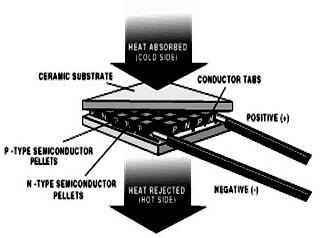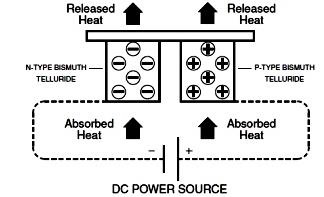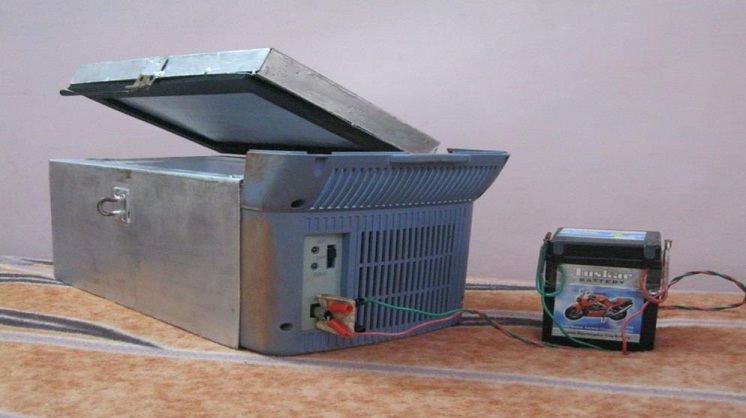





Published on Mar 01, 2025
The objective of this project work is to develop portable thermoelectric refrigeration system capable of maintaining vaccine temperatures between 8 °C and 13 °C. The main system consisted of thermoelectric module as cooling generator along with insulated cabin, battery and charging unit. Thermoelectric elements perform the same cooling function as Freon-based vapor compression or absorption refrigerators. To ensure the success of this project several criteria’s are to be satisfied such as portability, size and cost of the system.
The design of the preservator is based on the principles of thermoelectric module (i.e., Peltier effect) to create a hot side and a cold side. The cold side of the thermoelectric module is used for refrigeration purposes; provide cooling to the vaccine chamber. On the other hand, the heat from the hot side of the module is rejected to the surroundings with the help of heat sinks and fans. After gathering experimental data’s and necessary guidelines from research papers on the thermoelectric refrigeration systems, the initial design of the model was made.
Based on the heat load calculations, the thermoelectric module is selected. The system was fabricated and was experimentally tested for the cooling purpose. The capability of the system to maintain the required temperature and the time for reaching the same were analyzed. The results showed that the system can maintain the vaccine storage temperature at 8°C and 13 °C under ambient temperature up to 30 °C with minimum power consumption of 34 Watt. The proposed thermoelectric module, to maintain the vaccine storage temperature, satisfied the design criteria. Coefficient of performance of the vaccine preservation (COPR) was calculated and found to be about 0.106.
In 2002, an estimated 2.1 million people around the world died of diseases that were preventable by widely available vaccines. This toll included 1.4 million under the age of five. Among these deaths, over 500,000 were caused by measles; nearly 400,000 by hemophiliac influenza; nearly 300,000 by pertussis; and 180,000 by neonatal tetanus. Moreover, in 2003, around 27 million children worldwide were not reached by the vaccines, including 9.9 million in South Asia and 9.6 million in sub- Saharan Africa. Those who missed out on routine vaccination programs tended to be people living in remote areas, urban slums and border areas. They also included indigenous groups, displaced populations, and people lacking access to vaccination (WHO1, 2005).
One of the most important barriers to effective vaccination programs in remote areas is the spoilage of vaccines, even before their arriving at the remote locations for the end users. Vaccine chamber and handling practice deficiencies have been a serious on-going problem. (Woodyard et al, 1995 and Bishai et al., 1992). It has been reported that about 50 % of transported vaccines are thus wasted. (Sabeena, et al., 2002). In a remote Colorado County, about 93% of vaccine refrigerators were found to have temperatures outside the acceptable range (Woodyard et al., 1995).
Unreliable access to electrical power in remote areas is a barrier to maintaining potency of vaccine products. Approximately 1.6 billion people today do not have access to electricity, and four out of five people having unavailability of electricity live in rural areas (Birol, 2002).The most common cooling system utilized for cooling vaccines at health posts is with the vapour compression refrigerator and cold boxes. The vapour compression system employs mechanical pumps to actuate the compression and the subsequent expansion of specific working fluids. The advantage of this system is that it is capable of refrigerating large loads with high efficiency. However, the system is heavy due to the compressor, is costly and noisy during operations.
Thus, the system is not suitable or readily portable to remote areas. Alternatively, the cold box (vaccine carrier), which weighs and costs less, simply uses an ice pack to cool the vaccines. It is much less reliable, and offers cooling over a relatively short duration. Another alternative cooling technology which is becoming increasingly popular and attractive to the portable cooling application is thermoelectric modules. The modules are made of semiconductor materials electrically connected in series configuration and thermally in parallel to create cold and hot surfaces.
Although they are less efficient than the vapour compression system, they are very light, low in cost, silent in operation, and are environmentally friendly. In this project work, the thermoelectric module was utilized for cooling. The objective of this present work is to develop a workable portable thermoelectric cooling system with a capacity of 4 liters of vaccine chamber, with the temperature maintained between +10 °C to +12°C. It will be used in remote locations in the world where there is no grid electricity, and where electrical power supply is unreliable.
A voltage difference is produced when two wires of different materials are joined together at its end and heated at one its end, this phenomenon was discovered by Thomas Seebeck in 1821 and is known as the Seebeck Effect. The two main applications of Seebeck effect include temperature measurement and power generation. Fig 3.1: Seebeck effect: two wires of different metals are connected to a closed circuit. If one end is heated a current will flow continuously.
Thirteen years later Jean Charles Anthanase reversed the flow of electrons in Seebeck’s circuit to create refrigerating effect. This phenomenon is known as “Peltier Effect”. This idea forms the basis for the thermoelectric refrigerator.
In 1854, Scottish scientist William Thomson (later Lord Kelvin) discovered that if a temperature difference exists between any two points of a conductor carrying current, heat is either evolved or absorbed depending upon the material. If such a circuit absorbs heat, then on reversing the direction of the current or the temperature gradient heat may be evolved.
Although thermoelectric effect was discovered more than 150 years ago, thermoelectric devices (TE modules) have only been introduced commercially during recent decades. For some time, commercial TEs have been developing in parallel with two mainstreams of technical progress – electronics and photonics, particularly optoelectronics and laser techniques. Lately, a substantial increase in the application and use of TE solutions in optoelectronic devices has been observed, such as diode lasers, photo detectors, solid- state pumped lasers, charge-coupled devices (CCDs) and others. The progress in applications is due to the following advantages – they are solid state, have no moving parts and are miniature, highly reliable and are flexible in their design to meet particular requirements.

When a DC voltage is applied to the module, the positive and negative charge carriers in the pellet array absorb heat energy from one substrate surface and reject it to the other substrate at the opposite side. The surface where heat energy is absorbed becomes cold; the other surface where heat energy is released becomes hot. Reversing the polarity will result in reversed hot and cold sides. The Peltier effect can be described by the Peltier coefficient, Π, which is a measure of the energy carried per unit charge and is relatively large in semiconductors. The Peltier effect between two metals is quite small.

This is due to the fact that the conduction electrons in a metal have energies very close to the Fermi energy, which is the highest energy level, occupied by the electrons at absolute zero. Thus to better understand the Peltier coefficient a semiconductor will be considered since semiconductors tend to have relatively high Peltier coefficients.
The common way of presenting the Peltier coefficient is the following:
P = S.T
Here ’S’ is the Seebeck coefficient defined by contacting materials, their properties and temperature.
T is the junction temperature in Kelvin.
A TE module consists of thermoelectric couples (n and p type semiconductor legs) that are connected electrically in series and thermally in parallel configuration and are soldered together, sandwiched between two ceramic plates. The latter form the hot and cold side of the thermoelectric cooler (TEC). The configuration of TE modules is shown in figure 4.1 Commonly, a TE module consists of the following parts.
pellets. Usually, the semiconductor materials such as bismuth telluride, antimony telluride or their solid solutions are commonly used. The semiconductors are the best materials to be used due to a complex optimal TE performance and technological properties.
The plates provide mechanical integrity of a TE module. They must provide good electrical insulation from the object to be cooled and the heat sink. The plates must have good thermal conductance. The aluminium oxide (Al2O3) ceramics are most widely used due to the optimal cost to performance ratio and developed processing technique. Other ceramics, such as aluminium nitride and beryllium oxide are also used.
They provide electric contacting of pellets and contacts to leading wires. For most of the low-power modules, the conductors are made as thin films and multilayer structure containing copper (Cu) as a conductor, deposited onto ceramic plates. The high-power modules are made from Cu tabs in order to reduce resistance.
The solders used include antimony-tin and lead-tin alloys. The solders provide good assembling of the module. The melting point of a solder is one of the limiting factor of operating temperature of the module. For better life of the module, operation temperature must be well below the melting point of the solder material.
They are connected to the ending conductors to deliver power from a direct current (DC) electrical source.
A single-stage module consists of only one matrix of pellets and a pair of cold and warm sides (see figures). A multi-stage module can be viewed as two or more single stages stacked on top of each other. The construction of a multi-stage module is usually of a pyramidal type and each of the lower stage is bigger than the upper stage. Once the top stage is used for cooling the lower stage requires higher cooling capacity to pump heat that is dissipated from the upper stage.
In this proposed work, the main aim is to develop a portable refrigeration system with a capacity of 4 litres of vaccine chamber. The system should be capable of maintaining the temperature of the vaccines between +2°C and +12 °C range for a long time. Since the system has to be used in remote areas where power is scarce, alternative sources of energy like battery or solar power has to be incorporated in the design. Since the system has to be portable, it should be compact as well as light. Moreover the system is meant for outdoor use which makes better insulation and radiation control mandatory. In order to meet worse scenario, even though the system is to designed for maintaining a fixed chamber temperature throughout the operational period, the design should be such that it can adaptable for refrigerating the chamber from ambient temperature to the required temperature.
Cabin Walls- The rectangular double walled cabin is made using Mild steel sheets of 1mm thickness. The Designed dimension (27mm x 15mm x 13mm), of the cabin is obtained by performing suitable bending operations on the MS sheet. To give better surface finish the sides are welded together. The top door panel of the cabin is fastened using spot welding. Rubber beading is given to prevent the heat leakage, through the sides of the top door panel. To prevent radiation heat transfer and to give better surface finish, the outside of the cabin is coated with aluminium paint.
Insulation- Expanded polystyrene foams are made by mixing the polystyrene with a solvent, adding a gas under pressure and finally the mixture is extruded to produce the required thickness. The extrusion process improves the characteristics of the final foam, i.e. its mechanical resistance increases, producing non-interconnecting pores and a more homogeneous material. The value of mechanical resistance of expanded polystyrene foams can vary from 0.4 to 1.1 kg/cm2. There are several grades of foams available with their densities vary from 10 to 33 kg/m3, with thermal conductivities that are lower with the increase in density. EPS slabs with 20 mm thickness having a density of 30kg/m3 were used to give the required thermal insulation. The slabs having a thermal conductivity of 0.33 W/mk, were pasted to the inside walls of the cabin using a mixture of MDI (methyl-di-isocyanides) and caster oil.
Mounting of module has to be done with utter most care. It is mounted in the following steps.
1) The surface of the fin, to be attached to the Peltier Module is wiped free off dirt and grease using alcohol or similar and thin film of thermally conductive silicon grease on the suitable surfaces.
2) In the same way, heat emitting side of the Peltier Module is wiped with alcohol or similar and thinly spread with thermally-conductive silicon grease.
3) The heat-emitting side of the Peltier Module is placed onto the appropriate place on the radiator fins, taking care that while applying light pressure to the unit, slide the unit back and forth, left and right, approximately 20 times to ensure a perfect fit and to lose any layer of air between the connecting sides.
4) As heat absorbing side of the Peltier Module is made free of dirt and grease, in the same way, the surface of the aluminium block is wiped to attached to the Peltier Module with alcohol or similar and thinly applies thermally-conductive silicon grease.

5) The aluminium block is placed onto the heat absorbing side of the Peltier Module. Then once again, apply light pressure to the block and gently slide it back and forth, then left and right, to ensure a tight fit and remove any layer of air between the connecting sides.
6) The screws are tightened until the washers are properly held in place. While doing so, to ensure that even force is applied across the module, apply 200 ~ 300 N (for a 30 mm square unit) of pressure to the centre of the aluminium block and tighten each of the screws alternatively little by little.
7) When the module is gently secured, tighten the screws alternately in the same manner as in step 8 to a torque of 10 Nm. Continue tightening to a final torque of20 ~ 30 Nm.
8) As a protection against humidity, seal the perimeter of the TE Module with a silicon sealant or similar and allow to dry for the requisite time.
We have been successful in designing a system that fulfils the proposed goals. However we do realize the limitations of this system. The present design can be used only for maintaining a particular temperature. The system is unable to handle fluctuations in load. Extensive modifications need to be incorporated before it can be released for efficient field use. Thermoelectric refrigeration is one of the key areas where researchers have a keen interest. Some of the recent advancements in the area surpass some of the inherent demerits like adverse COP. Cascaded module architecture has defined new limits for its application. Moreover recent breakthrough in organic molecules as a thermoelectric material promises a bright future for TER. With more and more countries showing interest in Montreal and Kyoto protocol, TER is gaining more attention as an affordable, reliable and a green refrigeration alternative.
1. Sabah A. Abdul-Wahab , Ali Elkamel b, Ali M. Al-Damkhi , Hilal S. Al-Rubai’ey, Abdulaziz K. Al-Battashi , Muhammad U. Chutani (2009), Design and experimental investigation of portable solar thermoelectric refrigerator;An International Journal for Renewable Energy
2. Dai YJ, Wang RZ, Ni L;. Experimental investigation and analysis on a thermoelectric refrigerator driven by solar cells. Sol Energy Mater Sol Cells 2003.
3. Field RL;. Photovoltaic/thermoelectric refrigerator for medicine storage for developing countries. Sol Energy2010.
4. Chen K, Bwilliam SB.; An analysis of the heat transfer rate and efficiency of thermoelectric cooling systems.; Int J Energy Res 2009.